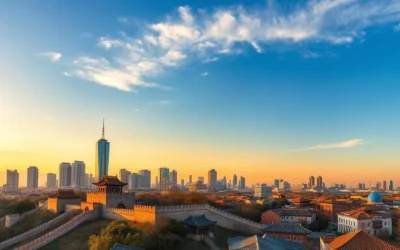✓ Accommodations✓ Flights✓ Rental Cars
When you explore the linguistic landscape of Shaanxi, you’ll discover a rich tapestry of language and culture. This region is home to a fascinating mix of dialects, each reflecting its unique history and traditions. The primary language spoken here is Mandarin, which serves as the official tongue for most residents.
Beyond Mandarin, you’ll encounter a variety of local dialects that add depth to the region’s identity. These dialects are not just ways of speaking but also windows into the area’s past. For instance, Jin Chinese, spoken by millions, showcases the enduring influence of historical developments.
Understanding these linguistic nuances helps you appreciate how dialect and culture intertwine in Shaanxi. Whether you’re a language enthusiast or a curious traveler, this region offers a captivating glimpse into the power of words.
Exploring China’s Rich Linguistic Landscape
China’s linguistic diversity is a fascinating blend of history, culture, and geography. With over 302 living languages and dialects, the country’s linguistic mosaic is one of the most complex in the world. This variety reflects the vastness of its territory and the unique traditions of its people.
Overview of Major Language Families
The linguistic landscape is shaped by five primary language families: Sino-Tibetan, Altaic, Austroasiatic, Hmong-Mien, and Tai-Kadai. Mandarin, the official language, is spoken by over 80% of the population. Other significant families include Wu, spoken in the Yangtze River Delta, and Yue (Cantonese), prevalent in Guangdong and Hong Kong.
Each language family has distinct characteristics. For example, Mandarin is tonal, with four main tones, while Cantonese has a more complex phonetic system. These differences highlight the richness of the country’s linguistic heritage.
Distinct Regional Expressions
Regional dialects add another layer of diversity. In Inner Mongolia, Jin Chinese is widely spoken, reflecting the area’s historical ties to Shanxi. Similarly, the Min language group, prevalent in Fujian, has spread to Southeast Asia due to historical migrations.
Urbanization has also influenced language use. As people migrate from rural to urban areas, regional dialects blend with Mandarin, creating unique linguistic hybrids. This dynamic interplay ensures that the linguistic landscape continues to evolve.
| Language Family | Primary Regions | Speakers (Millions) |
|---|---|---|
| Mandarin | Nationwide | 1,100 |
| Wu | Yangtze River Delta | 85 |
| Yue (Cantonese) | Guangdong, Hong Kong | 70 |
| Jin | Shanxi, Inner Mongolia | 63 |
Understanding these linguistic nuances helps you appreciate the cultural depth of this region. Whether you’re exploring bustling cities or rural villages, the spoken word offers a window into the country’s rich heritage.
The Evolution of Chinese Language and Dialects
From ancient scripts to modern dialects, the evolution of Chinese language reflects centuries of transformation. Over time, cultural shifts and political changes have shaped the way people communicate. This journey reveals how language adapts to the needs of its speakers.

Historical Milestones in Language Development
The Chinese language has roots dating back to the Shang Dynasty, where oracle bone scripts were used. These early forms laid the foundation for modern writing systems. By the Han Dynasty, Classical Chinese became the standard for literature and administration.
During the Tang Dynasty, poetry flourished, influencing the way people expressed themselves. This period also saw the spread of Buddhism, which introduced new vocabulary. The Song Dynasty brought further changes, with the rise of vernacular literature.
The Impact of Dynasties on Modern Speech
Different dynasties left their mark on the language. For example, the Yuan Dynasty introduced Mongolian influences, while the Ming Dynasty reinforced Classical Chinese. The Qing Dynasty saw the rise of regional dialects, which continue to shape modern speech.
Today, Mandarin, also known as Putonghua, is the most widely spoken language. It serves as a unifying force across diverse regions. However, local dialects like Cantonese and Wu remain vital in their respective areas.
Understanding this evolution helps you appreciate the rich linguistic heritage of the region. Whether you’re exploring a bustling city or a rural area, the spoken word offers a window into the past.
Shaanxi Province, China: Official and widely spoken languages
In northern China, the way people speak today reflects centuries of history and culture. The region’s linguistic landscape is shaped by its rich past, blending ancient traditions with modern forms of communication. Mandarin, the official language, serves as a unifying force, spoken by over 70% of the population.
Beyond Mandarin, local dialects like Jin Chinese add depth to the region’s identity. Jin, spoken by around 45 million people, showcases the enduring influence of historical developments. These dialects are not just ways of speaking but also windows into the area’s past.
The integration of traditional culture with modern language forms is evident in everyday life. Historical documents from the 13th century BC reveal the roots of these dialects, while contemporary accounts highlight their evolution. This dynamic relationship ensures that language remains a vital part of the region’s identity.
Understanding the cultural and historical significance of these dialects helps you appreciate their role in shaping the region’s identity. Whether you’re exploring bustling cities or rural villages, the spoken word offers a window into the past.
| Language | Speakers (Millions) | Historical Significance |
|---|---|---|
| Mandarin | 836 | Unifying language since the 20th century |
| Jin | 45 | Roots in ancient northern dialects |
| Wu | 77 | Influenced by Tang Dynasty poetry |
Today, the dialects of northern China continue to evolve, blending historical influences with modern needs. This linguistic diversity is a testament to the region’s rich heritage and its ability to adapt over time.
Regional Dialects and Local Variations in Northern China
The dialects of northern China offer a fascinating glimpse into the region’s cultural and historical evolution. These linguistic variations are not just ways of speaking but also windows into the past. Among them, Jin Chinese stands out as a unique example of how language spoken locally mirrors broader trends in the world of linguistics.

Jin Chinese: A Case Study from Shanxi
Jin Chinese, primarily spoken in Shanxi, has evolved over centuries. Its roots trace back to ancient pronunciations and vocabulary that are no longer present in other dialects. This makes it a living relic of the region’s linguistic history. Unlike standard Mandarin, Jin retains distinct phonological features, such as tonal variations and retroflex sounds.
The development of Jin Chinese was heavily influenced by historical dynasty changes. For instance, during the Yuan Dynasty, Mongolian influences shaped its vocabulary and pronunciation. Later, the Ming and Qing Dynasties reinforced its unique characteristics, ensuring its survival alongside Mandarin.
- Unique Features: Jin Chinese has retained ancient pronunciations, making it distinct from other dialects.
- Historical Influence: Dynastic changes played a key role in shaping its evolution.
- Modern Usage: Despite the dominance of Mandarin, Jin remains vital in local communication.
Today, Jin Chinese continues to adapt, blending historical influences with modern needs. Its resilience highlights the importance of regional dialects in preserving cultural identity. Whether you’re a language enthusiast or a curious traveler, exploring Jin offers a deeper understanding of northern China’s linguistic heritage.
Cultural Significance of Local Dialects
Local dialects are more than just words; they are a bridge to cultural heritage. These spoken languages carry the essence of a community’s traditions, history, and identity. They connect people across generations, preserving stories that might otherwise be lost.
For many ethnic groups, dialects are a way to express their unique identity. They serve as a reminder of shared roots and common experiences. In regions like Southeast Asia, these dialects have even helped migrant communities maintain ties to their homeland.
Traditions, History, and Identity
Dialects often reflect the history of a region. For example, the Guanzhong dialect in northern regions has roots in ancient dynasties, serving as a living link to the past. This Chinese language variant showcases how speech evolves alongside cultural changes.
Here’s how dialects contribute to cultural identity:
- Preserving History: Dialects carry narratives of historical events, passed down through generations.
- Bonding Communities: They create a sense of belonging among speakers, fostering unity.
- Expressing Traditions: Local idioms and phrases often reflect unique cultural practices.
Understanding these dialects helps you appreciate the deep emotional connections they represent. Whether it’s a family sharing stories or a community celebrating its heritage, language is at the heart of it all.
Economic and Social Influences on Language Usage
Economic and social changes have reshaped how languages are used across regions. As communities grow and adapt, their language spoken evolves to meet new needs. This transformation is especially evident in the way people balance regional tones with the adoption of an official language for education and business.
Modern communication methods, like social media and global trade, have accelerated this shift. For example, urbanization has led to a 50% increase in code-switching practices among younger generations. This blending of dialects with Mandarin highlights the dynamic interplay between tradition and progress.

Economic development also plays a key role. As regions become more interconnected, the need for a common language grows. Mandarin, as the official language, serves as a bridge for business and education. Yet, local dialects remain vital in preserving cultural identity.
Here’s how economic and social factors influence language usage:
- Education: Schools prioritize Mandarin for national unity, but regional tones are still taught.
- Business: Companies use Mandarin for broader reach, while local dialects connect with communities.
- Technology: Social media platforms encourage bilingualism, blending dialects with standard speech.
Understanding these trends helps you see how language adapts to societal changes. Whether it’s a rural village or a bustling city, the way people speak reflects their history and future aspirations.
| Factor | Impact on Language | Example |
|---|---|---|
| Urbanization | Increased code-switching | 50% rise in urban areas |
| Education | Mandarin as primary language | National curriculum standards |
| Technology | Bilingual communication | Social media platforms |
For more insights on how economic and cultural factors shape language, explore this detailed study. It highlights the complex relationship between economic growth and linguistic diversity.
How Geography Shapes China’s Linguistic Diversity
Geography plays a pivotal role in shaping the linguistic diversity found across regions. Natural barriers like mountains and rivers create isolated communities, fostering unique dialect spoken variations. These physical features act as boundaries, preserving distinct language features over time.
Natural Barriers and Isolated Communities
In regions surrounded by mountains, communities develop their own linguistic identities. The Qinling Mountains, for example, have historically separated northern and southern dialects, leading to significant differences in speech patterns. Rivers like the Yangtze and Yellow River also serve as natural dividers, influencing how dialect spoken evolves in adjacent areas.
These geographic features not only isolate communities but also encourage the addition of local cultural elements to language. Over time, this results in dialects that are rich in history and tradition.
Contrasting Examples: Isolated vs. Dynamic Settings
While isolated regions preserve ancient dialects, dynamic metropolitan areas like Hong Kong showcase linguistic evolution. In Hong Kong, Cantonese thrives alongside Mandarin and English, reflecting the city’s global influence. This contrast highlights how geography and urbanization shape language in different ways.
- Isolated Communities: Develop unique dialects due to geographic barriers.
- Dynamic Settings: Encourage linguistic blending and adaptation.
- Cultural Influence: Local traditions enrich language features.
Understanding these geographic influences helps you appreciate the complexity of linguistic diversity. For more insights, explore this detailed study on the topic.
Comparing Chinese Varieties: Mandarin, Wu, Cantonese, and More
Exploring the linguistic landscape reveals fascinating differences among Chinese varieties. Each variant carries unique phonetic, grammatical, and cultural traits. From the widespread use of Mandarin to the regional charm of Wu and Cantonese, these languages paint a vivid picture of diversity.

Distinct Characteristics of Each Variant
Mandarin, spoken by 65.7% of the population, is known for its four tones and straightforward grammar. In contrast, Wu, prevalent in regions like Jiangsu and Zhejiang, uses eight tones and retains more Middle Chinese final consonants. Cantonese, with its six tones, is widely spoken in Guangdong and Hong Kong, offering a complex phonetic system.
Regional dialects like those in Hunan Province and Jiangxi Province add further layers of complexity. For example, Xiang, spoken in Hunan, has five tones and distinct vocabulary. Meanwhile, Gan, common in Jiangxi, shares similarities with Hakka but remains unique in its pronunciation.
The Global Impact of Cantonese and Mandarin
Mandarin’s global influence is undeniable, with over 920 million native speakers. It serves as the official language and a unifying force across regions. Cantonese, with 86 million speakers, has a strong presence in international communities, particularly in Southeast Asia and North America.
“The global reach of these languages highlights their cultural and economic significance.”
Understanding these differences helps you appreciate the richness of Chinese linguistic heritage. For more insights, explore this detailed guide on the topic.
Modern Communication and Language in a Globalized World
In today’s digital age, the way we learn and use languages is transforming rapidly. Technology has become a powerful tool, breaking down barriers and connecting people across the globe. From mobile apps to online platforms, modern communication is reshaping language education and its distribution worldwide.
Integration of Technology in Language Learning
Language learning has entered a new era, driven by technological advancements. Apps like Duolingo and Babbel have made it easier than ever to pick up new languages. These platforms offer interactive lessons, making learning engaging and accessible to everyone.
Online courses and virtual classrooms also play a significant role. They allow learners to connect with native speakers and instructors from different territories. This global approach ensures a deeper understanding of cultural nuances.
Here’s how technology is revolutionizing language education:
- Accessibility: Mobile apps bring language learning to your fingertips.
- Personalization: AI-driven platforms tailor lessons to individual needs.
- Global Reach: Online courses connect learners worldwide, fostering cultural exchange.
Language distribution is also evolving. As digital tools become more widespread, minority languages gain visibility. For example, apps like Memrise now offer courses in endangered dialects, helping preserve linguistic diversity.
Understanding these trends helps you see how technology is shaping the future of communication. Whether you’re learning a new language or preserving an old one, digital tools are making it easier than ever. For more insights, explore this detailed guide on linguistic diversity.
Conclusion
The linguistic landscape across regions is a testament to the power of variation. From the unifying force of Mandarin to the unique charm of local dialects, each name carries a story. Historical, geographic, and social factors have shaped how people communicate, creating a rich tapestry of speech patterns.
Understanding these variations helps you appreciate the cultural depth they represent. Whether it’s the tonal complexity of Cantonese or the ancient roots of Jin, each dialect offers a window into the past. These languages are not just tools for communication but also markers of identity.
As you explore this diversity, you’ll see how language adapts to modern needs while preserving tradition. For a deeper dive into the richness of these dialects, check out this detailed guide. It’s a journey worth taking.
The above is subject to change.
Check back often to TRAVEL.COM for the latest travel tips and deals.






